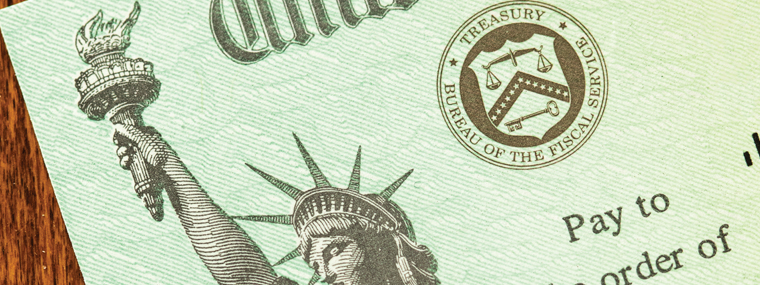
Financial
The COVID Emergency Relief Act
By Mark E. Battersby / Published March 2021

In December 2020, Congress passed an additional round of COVID-19 relief. Despite containing a number of business-related provisions, the Consolidated Appropriations Act of 2021 largely made the news with general benefits such as the following:
- The $166 billion allocated for economic impact payments of $600 for individuals making up to $75,000 per year and $1,200 for married couples making up to $150,000 per year, as well as a $600 payment for each dependent child.
- $120 billion to provide workers receiving unemployment benefits a $300 per week supplement from December 26 until March 14, 2021. Of interest to self-employed pressure washers, independent contractors, and so-called “gig” workers, the bill also included an extension of the Pandemic Unemployment Assistance (PUA) program, from December 31, 2020, until March 14, 2021. Eligible individuals can receive up to 50 weeks of PUA with no one eligible to receive it after April 5, 2021.
- The Pandemic Emergency Unemployment Compensation (PUC) program that provided additional weeks of federally funded unemployment benefits to individuals who have exhausted their regular state benefits has also been extended.
- $25 billion in emergency rental aid and an extension of the national eviction moratorium which was further ex-tended until March 31 by one of President Biden’s early executive orders.
Employers Benefit As Well
The wide-sweeping bill contained quite a few provisions that impact employers, both in the private and public sectors, in 2021. Among the most significant provisions are the following measures:
- Extension of the refundable payroll tax credit for paid sick and family leave that was enacted as part of the Families First Coronavirus Response Act (FFCRA), through March 2021. The new bill also allows individuals to use their average daily self-employment income from 2019 rather than 2020 when computing the tax credit.
- Extension of the Employee Retention Credit (ERC), the fully refundable payroll tax credit for employers paying the wages of qualified workers and their health plan expenses, through June 30, 2021. The ERC for wages paid between January 1, 2021, and June 30, 2021, will be equal to 70 percent of qualified wages rather than the former 50 percent. Plus, the ERC cap on qualified wages has been increased from $10,000 of wages per employee per year to $10,000 of wages per employee per calendar quarter.
- Extension of the time allotted for repayment of employee Social Security Taxes deferred under former President Trump’s Memorandum through the end of 2021. This applies to payroll taxes on wages paid from September 1 through December 30, 2020. Under the moratorium, employers were required to increase withholding and pay the deferred amount ratably in the first quarter of 2021. The bill has extended the repayment period through December 31, 2021.
Unfavorable News For Employers
The bill did not extend the mandates of Families First Coronavirus Response Act (FFCRA) created as part of last summer’s CARES Act. However, although FFCRA no longer requires certain employers to provide employees with paid sick leave or expanded family and medical leave for COVID-19, except on a voluntary basis, the new COVID relief bill allows employers another calendar quarter of paid leave tax credits.
The newly amended FFCRA rules allow employers to take a payroll tax credit for providing emergency paid “sick leave” and paid expanded “family medical leave” into the first quarter of 2021 to recover the costs of providing required FFCRA leave in 2020 and for “voluntarily” providing emergency leave and family medical emergency leave through March 31, 2021.
Businesses Not Overlooked
The new legislation included a number of provisions aimed at helping pressure cleaning businesses—and their owners—survive the pandemic, including the following:
- Although designed to help the restaurant industry, restoration of the deduction for business meals for 2021 and 2022 will allow pressure washing businesses to deduct 100 percent of the cost of business meals with clients. The bill temporarily allows a 100 percent business expense deduction for meals (rather than the current 50 percent) as long as the expense is for food or beverages provided by a restaurant. Effective for expenses incurred after December 31, 2020, the provision expires at the end of 2022.
- IRAs and other retirement plans can now be used for “disaster mitigation.” Residents in qualified disaster areas can make a distribution of up to $100,000 from an Individual Retirement Account (IRA) or other retirement plan without penalty. Amounts withdrawn may be recontributed to the plan without consequences or included in income over a three-year period.
Funding Survival
The new legislation included approximately $325 billion in funding for the Small Business Administration (SBA) to assist small businesses that have been impacted by the COVID-19 pandemic. Included among the numerous small business funding opportunities are these provisions:
- Over $300 billion is allotted for small businesses struggling after nine months of the coronavirus pandemic. As mentioned, more than $284 billion has been provided to the Small Business Administration (SBA) for first and second PPP forgivable small business loans. It also allocates $20 billion to provide Economic Injury Disaster Loan (EIDL) grants to small businesses in low-income communities.
- The Economic Injury Disaster Loan (EIDL) program designed to provide economic relief to businesses that are currently experiencing a temporary loss of revenue due to the coronavirus pandemic has received a second round of funding. The new law also replenished the EIDL Advance Fund, which allows business suffering a substantial economic injury to apply for an advance that does not need to be repaid for up to $1,000 per employee limited to $10,000 total. Also eliminated was the requirement that PPP borrowers deduct the amount of an EIDL advance from their PPP forgiveness amount.
Of course, the big news is the renewal of the Paycheck Protection Program (PPP).
PPP Again
The new bill provides $284 billion to reopen and strengthen the PPP for both first-time and second-time borrowers. As with the original PPP, thanks to PPP2, small businesses can borrow money from private lenders without collateral, personal guarantees, or fees. These loans don’t have to be repaid to the extent they have been used to cover certain expenses.
Among the features of the restored PPP is a process for businesses to receive a second PPP loan if they have less than 300 employees and can show a 25 percent reduction in revenue in any 2020 quarter compared with the same quarter in 2019. Sole proprietors, independent contractors, and the self-employed are also eligible to apply.
In general, borrowers are eligible for PPP loan forgiveness if they apply at least 60 percent of the proceeds to payroll. Partial loan forgiveness may be available to those failing to meet this threshold. Borrowers may spend up to 40 percent on other qualified expenses during the covered periods.
In addition to rent, mortgage interest, and utilities, the list of eligible non-payroll expenses has been expanded to include worker protection and facility modification expenditures including PPE and operating costs such as software and cloud computing services.
The maximum loan amount is $2 million for “second draw” loans, down from the $10 million maximum that applied under the original CARES Act. Most borrowers can qualify for a loan of up to 2 1/2 times their average monthly payroll costs, and PPP loans that aren’t forgiven are subject to an interest rate of one percent.
Reversing an earlier ruling by the IRS, business expenses paid with PPP funding would be tax deductible. Beware, however—many states may not go along with allowing these deductions together with loan forgiveness, with the result of an unexpected state tax bill.
Unfortunately, the bill rescinded amounts formerly appropriated under the CARES Act for direct loans by the Treasury and emergency lending by the Federal Reserve. That means the end of several lending programs, including the Main Street Loans.
In Other Areas
Somewhat more targeted, the new bill contains the following provisions in several areas:
- The New Markets Tax Credit, the program for encouraging tax-favored investments in economically depressed areas, has been extended for five additional years at 2020 levels.
- The popular Work Opportunity Tax Credit that has proven successful in helping employers add disadvantaged individuals has also been extended for five years.
The $900 billion in coronavirus relief bill brings the total amount of government spending in response to the pandemic to more than $3.3 trillion, a staggering amount that highlights the unprecedented shutdown of the economy and the resulting fallout. Best of all, many of the benefits aimed at pressure cleaning contractors and businesses will stick around long after the pandemic is over.
The controversial $1.9 trillion American Rescue Plan, on the other hand, contains a third round of stimulus checks, funding for vaccine distributions, and more. However, beyond proposing a new $15 billion grant program for small business owners, separate from the existing PPP, and a push toward a universal $15 per hour minimum wage, there appears little that will impact on a pressure cleaning business.
Not so surprisingly, whether attempting to reap the maximum amount of funding, benefits, or tax breaks from last December’s COVID Relief bill, or new executive orders or Congressional legislation, professional assistance will be invaluable for every contractor and business owner.






